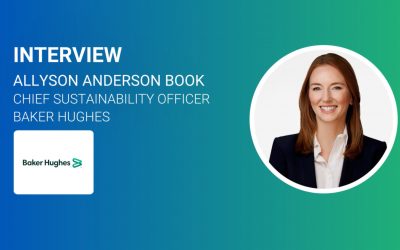Beyond ESG: A Behavioural Perspective on Corporate Sustainability
In the evolving landscape of corporate sustainability, traditional ESG metrics are increasingly being called into question for their limitations in driving meaningful change. To explore a more nuanced approach, Climate Action spoke with Livio Scalvini from the Leonardo Centre on Business for Society at Imperial College London about their groundbreaking research into corporate sustainability behaviours. Their work reveals how a behavioural lens can offer deeper insights into how companies create long-term value while aligning with social and environmental goals.
.png)
For a deeper dive into the research and findings, you can access the full report on the Leonardo Centre’s website.
Q: To begin, what prompted your research team to move beyond traditional ESG scores and instead examine sustainability behaviours at a deeper level?
Our starting point was an awareness of three major trends shaping the private sector's sustainability transition. First, relying solely on moral imperatives is insufficient. The global community is increasingly off-track in meeting the objectives of the 2030 Agenda, with rising geopolitical divergence further complicating coordinated responses. Second, the so-called “reporting revolution” is still in its early stages, with initiatives like the CSRD and related frameworks striving for convergence. Finally, there’s growing recognition of the limitations of conventional ESG metrics in truly capturing corporate sustainability.
Our research aims to answer fundamental questions: What business models align with human expectations of economic and social wellbeing within planetary boundaries? What transformational changes are necessary in mindsets, business models, and markets to realize an economic system fit for purpose?
We systematically analyse companies’ actions to determine which generate trade-offs between impact and shareholder returns, and which create synergies. The need for a completely different approach—based on identifying and categorizing sustainability initiatives and scientifically assessing their financial and non-financial performance implications—became absolutely clear.
Q: Your findings suggest that not all sustainability actions exert equal influence. Could you elaborate on the distinction between symbolic and transformational initiatives?
Indeed, this distinction is central to our research. Through the Leonardo Centre at Imperial College London, we’ve built a global, multidisciplinary platform to understand and accelerate systemic transitions toward a regenerative economy.Our proprietary dataset—documenting over 1 million sustainability initiatives by approximately 16,000 companies across 80 countries over the past 30 years—allows us to observe and classify patterns of corporate behaviour at scale.
From this empirical foundation, we developed a taxonomy of corporate sustainability behaviours based on three analytical dimensions: intent (why), thematic focus (what), and primary stakeholder targeted (for whom). We also categorize sustainability behaviours into three progressive stages: advocacy, preparation, and transformation.
- Advocacy activities (about 50% of observed initiatives) are largely symbolic, focusing on communications, philanthropy, and promotional campaigns.
- Preparation activities (around 30%) centre on internal processes like assessments and training.
- Transformational initiatives (the remaining 20%) involve substantial interventions such as business model innovation and organisational change—where we observe real impact on corporate performance.
The Business Impact Maturity (BIM) model offers a novel framework to understand how these practices evolve and contribute to value creation, situating firms along an evolutionary continuum from advocacy to transformation.
Q: One of the more striking results in your research is the reported 2.67% annual alpha for firms engaging in transformational sustainability. Could you provide context on what these behaviours entail?
This figure comes from a 13-year longitudinal analysis of firms in the US and Europe. Portfolios selecting companies with more transformational behaviours consistently outperformed market rates, achieving a 2.67% risk-adjusted annual return—cumulatively a 40% abnormal return over the study period.
By contrast:
- Advocacy-heavy portfolios underperformed.
- Preparation-focused portfolios showed no statistically significant difference from the market.
These findings are backed by advanced modelling (including Fama-French 3-factor models and Sharpe ratio comparisons). Transformational portfolios also exhibited stronger risk management, with lower volatility and more stable performance. We validated these results using accounting performance data, confirming that transformational behaviours correlate with core business fundamentals, not just market fluctuations. The competitive advantages include better talent attraction, cheaper capital, expanded customer bases, stronger supplier partnerships, and deeper community ties. Notably, ESG ratings failed to explain performance variance, as they correlate more with advocacy and preparatory actions, underscoring their limited ability to identify transformative practices.
Q: What are the implications of these findings for investors seeking to integrate sustainability in a financially meaningful way?
The key takeaway is the need to move beyond conventional ESG metrics toward indicators grounded in observable corporate behaviours. For passive investors, this could mean adapting portfolio strategies using behavioural indices based on SDG-related actions or thematic ETFs focused on specific SDG challenges. Screening tools that assess the strategic maturity of sustainability actions would significantly enhance performance.
For active investors, such as activist asset managers and private equity funds, the findings support impact-driven strategies—from proxy voting guided by behavioural analytics to value creation approaches centred on sustainability-driven innovation and transformation. Private equity investors, in particular, can leverage this data to reposition growth strategies around transformational change, especially in collaboration with value chain partners.
Q: And what guidance would you offer to corporate leaders balancing sustainability commitments with shareholder expectations?
Our research shows that transformational sustainability strategies are not only compatible with shareholder value creation but can be key drivers of the Business Impact Maturity (BIM) model offers a strategic roadmap for aligning sustainability initiatives with growth, innovation, and performance targets. It allows companies to benchmark progress, engage stakeholders with credibility, and ensure cross-functional alignment across strategy, governance, operations, and innovation. Rather than viewing sustainability as a compliance obligation, forward-thinking leaders should treat it as a pathway to long-term value creation.
Q: Finally, how do you foresee this research shaping the future of ESG investing and corporate sustainability strategy?
We believe the field is entering a new paradigm where impact measurement becomes central. At the investor level, we foresee broad adoption of behaviour-based metrics across asset classes. Collaboration will be crucial — we are actively working with financial institutions through dedicated co-laboratories to develop common standards and integrate these insights into decision-making processes. Ultimately, this is a collective endeavour. Whether you’re a policymaker, investor, or corporate leader, the message is clear: embrace the race to the top. We welcome collaboration with leaders who are ready to accelerate this transition and create shared value for all stakeholders.
To stay updated on this research, receive future insights, or explore collaboration opportunities with the Leonardo Centre, sign up for updates or get in touch with the Leonardo Centre directly.






